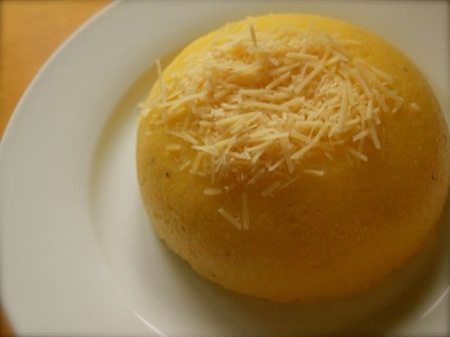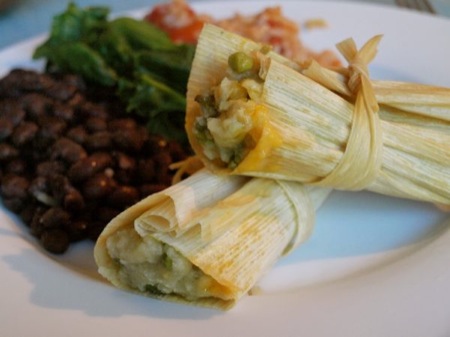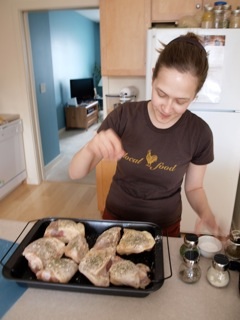This is the fourth post in the series “Great Grains” highlighting unusual whole grains and easy ways to incorporate them into your diet. Check out posts on bulgur, millet and rye as well.
Is it a grain or is it a vegetable? Is maize the same thing as corn? What counts as the “whole” grain form? Corn gets such a bad rap—Is it even healthy for you?
The United States is on track to produce one of the largest corn crops in history, yet when digging up info for a whole grains post on corn I ended up with more questions than answers. When it comes to corn, it seems everything is up for debate.
What is maize…or corn…or whatever it’s called?
Here’s the bottom line on the maize/corn name: they are one in the same. Maize was the Native American term, which was replaced by the English term “corn” somewhere before it became the most widely grown  Polenta!grain crop in the United States. Scholars will argue that maize was a different plant than the often genetically-modified crop harvested today, but for everyday kitchen, corn is the term to go with.
Polenta!grain crop in the United States. Scholars will argue that maize was a different plant than the often genetically-modified crop harvested today, but for everyday kitchen, corn is the term to go with.
Identifying corn as a grain or a vegetable has also been debated. Dried corn forms, including cornmeal, popcorn, grits, and masa (corn flour) are all considered grains. Our favorite Minnesota summertime sweet corn is not a whole grain, and is instead considered a vegetable by most nutritionists.
What’s great about it?
The last and most contentious debate centers around corn’s nutritional value. Despite being a sizable portion of nutrition around the globe, corn has been given the reputation as being “empty calories”, lacking in nutrition, and full of unnecessary sugar. This may be true of processed corn products, however in its whole grain form, corn is healthy and full of nutrients. Corn is high in fiber, B vitamins and has 10 times more Vitamin A than other grains. Research also suggests corn contains antioxidants that support eye health and reduce the risks of diabetes and hypertension. In order to receive all the benefits, be sure to purchase high-quality, non-genetically modified corn products with the Whole Grain Council seal on the package and not those listed as “de-germed” or “instant.”
What do I do with it?
Although it’s easy to find processed corn products and bi-products on the supermarket shelves, it is much harder to pull together a meal with whole grain corn. Start with these and be amazed by whole grain maize (oops, I mean corn...):
- Tamales – Mix 3 cups of masa harina (corn flour treated with lime) with a jar of green salsa, frozen
green peas and a cup of cheddar cheese. Toss in shredded cooked chicken or pork if desired. Season with fresh chopped cilantro, wrap in a corn husk and steam for 25-30 minutes. Homemade tamales
Homemade tamales - Popcorn –Although some nutritionists might argue that adding loads of butter and salt deflate the benefits, air-popped popcorn reigns as one of the best whole-grain snacks. Try new seasonings like garlic and fresh herbs, savory thyme and rosemary, or a sweet and spicy combo like brown sugar and cayenne pepper.
- Sweet Corn Soup – It may be more on the vegetable side than grain, but Simple, Good, and Tasty Contributor Adam Anderson’s recipe for a sweet corn soup with pan-roasted tomatoes and fresh thyme is worth the stretch. It’s perfect for a summertime dinner on the patio or a weekend lunch.
- Corn Pancakes – Start the morning off with a twist on breakfast. Mix whole grain cornmeal with flour, salt, baking powder, sugar, milk and an egg for a simple pancake batter. These pancakes are irresistible topped with maple syrup or ripe strawberries and blueberries.
- Creamy Polenta with Parmesan– Boil course ground whole grain cornmeal in vegetable stock for 20 minutes, stirring constantly until thick. Stir in 1 tablespoon of butter and allow to set. Turn out on a plate and top with freshly grated Parmesan cheese. Slice and serve with a favorite tomato sauce.
 Amy Sippl is a frequent contributor to Simple, Good, and Tasty. She grew up in rural Wisconsin, but now calls St. Paul her home. She writes about her successes and struggles to eat and grow local food on her blog: Minnesota Locavore. Her last article for us was: Keep your eye on Rye.
Amy Sippl is a frequent contributor to Simple, Good, and Tasty. She grew up in rural Wisconsin, but now calls St. Paul her home. She writes about her successes and struggles to eat and grow local food on her blog: Minnesota Locavore. Her last article for us was: Keep your eye on Rye.




